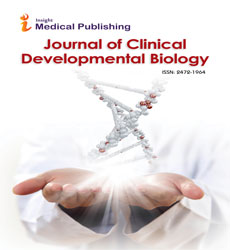E3 Ligases Coordinate Developmental Scenarios
Liyuan Chen
Liyuan Chen*
School of Life Sciences, Chinese University of Hong Kong, Shatin, New Territories, Hong Kong, PR China
- *Corresponding Author:
- Dr. Liyuan Chen
Research Assistant Professor, School of Life Sciences, Chinese University of Hong Kong
Shatin, New Territories, Hong Kong, PR China
Tel: 85239436334
E-mail: vliyuanchen@cuhk.edu.hk
Received date: November 25, 2015; Accepted date: November 27, 2015; Published date: November 30, 2015
Editorial
E3 ligases as versatile regulators coordinate a highly suitable mechanism to respond to cellular and environmental during the developmental processes and allow for the highly selective and rapid control by targeting substrate proteins for ubiquitylation and proteasomal degradation. Since the first molecular identification of Ubiquitin (UBQ) in 1975, UBQ dependent proteasome pathway has been demonstrated as one of the crucial regulatory mechanisms to equilibrate the quality of important proteins and orchestrate the diverse developmental scenarios in both Metazoans and Plants. Eukaryotes, such as Arabidopsis, Elegans and Zebrafish, employ the UBQ activating enzyme E1 to exchange the activated UBQ to an UBQ conjugating enzyme E2, which subsequently assemble with the UBQ ligase E3 and ubuquitylate the specific substrate target for the downstream proteasomal degradation.
CULLIN3 RING based E3 ligases (CRL3) as one typical representative conferring flexible regulations involved in cell division, embryogenesis and lateral organ development. In general, CRL3 E3 ligase recruits the substrate adaptor, which mediates the physical interaction with CULLIN3 and contains the BTB/POZ domain of Bric-a-brac, Tram track and Broad Complex/ Pox virus and Zinc finger. Besides this conserved BTB/POZ domain, two common protein interaction domains of Meprin and Traf-Homology and Ankyrin Repeat have been identified in both Metazoans and Plants. Most intriguingly, an increasing number of protein interaction studies demonstrated that the protein interaction domain on substrate adaptors contribute the diversity interaction between adaptors and substrates.
Thanks to the brilliant Next Generation Sequencing technologies, we shall harvest more putative E3 ligases assembled targets. Noteworthy, Quantitative Interaction Screeningcan generate many ideal interaction data-pools for an exact specific developmental stage within the focused tissue under stress conditions. For instance, based upon these data, we can decipher how E3 ligases equilibrate the activities of meristem stem cells in roots, shoots and inflorescences. Therefore, further deep investigations on the substrate recognition will discover the diverse spectrum of assembled targets, and also elucidate the neat regulatory module how E3 ligases regulate developmental events upon targeting substrates for proteasomal degradation.
Open Access Journals
- Aquaculture & Veterinary Science
- Chemistry & Chemical Sciences
- Clinical Sciences
- Engineering
- General Science
- Genetics & Molecular Biology
- Health Care & Nursing
- Immunology & Microbiology
- Materials Science
- Mathematics & Physics
- Medical Sciences
- Neurology & Psychiatry
- Oncology & Cancer Science
- Pharmaceutical Sciences
